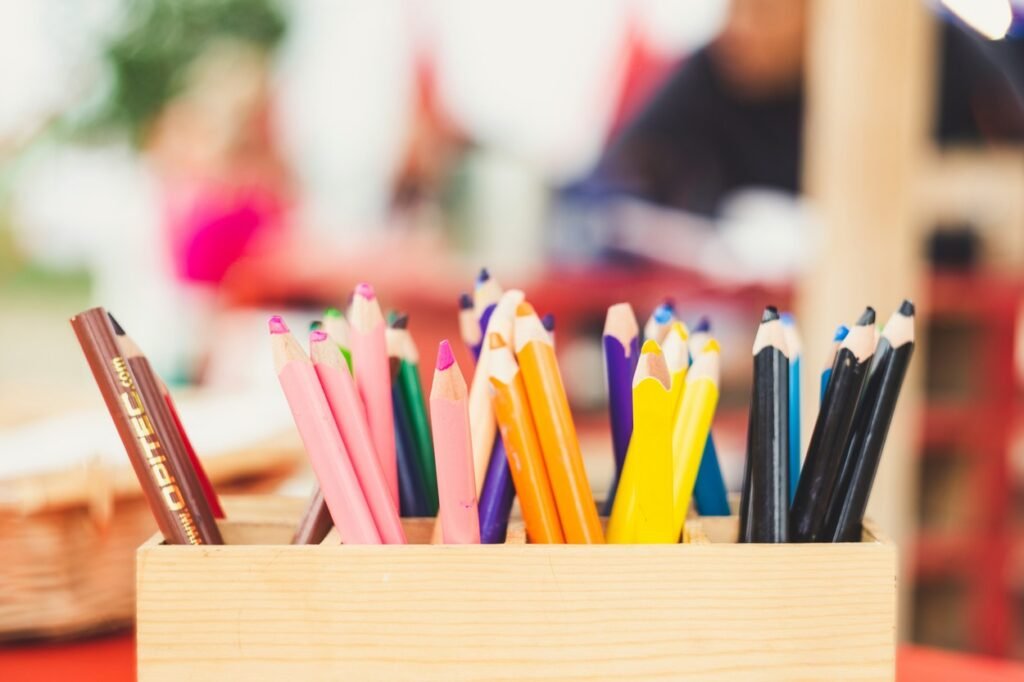If you’ve ever witnessed a toddler attempt to hold a pencil, you’ve likely experienced a combination of amusement, frustration, and awe. As a parent of two young children—a six-year-old boy and a five-year-old girl—I’ve had my fair share of pencil-related antics.
Watching my kids, especially in their early toddler years, navigate the perplexing task of gripping a pencil has been nothing short of a comedy show, with moments of pure joy and a sprinkle of hair-pulling exasperation.
The Initial Stage: The Fist Grip (a.k.a. “Caveman Style”)
The first time my son picked up a pencil, he did so with the enthusiasm of someone holding a turkey leg at a Renaissance fair. Grasping the pencil in his tiny fist, he attacked the paper with the grace of a caveman sketching on a cave wall. His grip was so tight, I feared the pencil might snap in two. And the lines? They were wild, uncontained, and completely unpredictable. It was as if he were trying to communicate through abstract art, which, come to think of it, is probably the best way to describe a toddler’s first attempts at drawing.
But, of course, every masterpiece begins with a single stroke, even if that stroke looks more like a chaotic scribble. I quickly learned that the “fist grip” is a completely normal and expected stage in a child’s pencil-holding journey. It’s a clear sign that your toddler is developing their fine motor skills, even if it does look like they’re more suited for drawing on cave walls than for writing their ABCs.

Evolution of the Grip: The Four-Fingered Pinch
After a few months of the caveman approach, my daughter began to evolve her technique. She ditched the fist grip and adopted a style I like to call the “four-fingered pinch.” This was an exciting development, albeit one that made her look like she was trying to delicately pluck a strand of spaghetti from a boiling pot.
In this stage, she would hold the pencil with four fingers pressed together on one side, using her thumb for support. The result? Slightly more controlled scribbles that, if I squinted, almost resembled intentional lines. The pencil still had a tendency to escape her grasp, but at least it wasn’t being held with the sheer brute force of before. Progress, no matter how small, is worth celebrating in the world of toddlerhood.
The four-fingered pinch phase is an important step in the development of a proper pencil grip. It shows that your child is beginning to refine their motor skills and gain more control over their hand movements. However, this phase can also be a bit frustrating for parents, as it often results in a lot of dropped pencils and an endless parade of scribbles that you’ll later find on your walls, floors, and occasionally, your own face.
The Three-Fingered Grip: Almost There!
Then comes the magical moment when your toddler discovers the three-fingered grip. This stage is a major milestone, and one that signals your child is on the cusp of mastering the art of holding a pencil. The three-fingered grip—also known as the tripod grip—involves holding the pencil between the thumb and index finger, with the middle finger providing support.
For my son, the transition to the tripod grip was a bit like watching someone learn to ride a bike without training wheels. There were a few wobbles, some minor crashes, and the occasional “I’m never doing this again!” meltdown. But eventually, he found his balance, and before I knew it, he was holding the pencil with the confidence of a seasoned artist.
Of course, this newfound confidence didn’t immediately translate into perfectly legible writing. In fact, his early attempts at letters looked more like abstract hieroglyphics. But the important thing was that he was holding the pencil correctly, and that was half the battle.

Tips for Encouraging the Proper Grip
As much as I’d love to claim credit for my children’s pencil-holding success, the truth is that a lot of it comes down to time, patience, and a few clever tricks I picked up along the way. Here are some tips that certainly worked for me:
- Start with Chunky Crayons: Before introducing a pencil, I gave my kids chunky crayons. Their larger size made them easier to grip, helping to build up those tiny hand muscles without the frustration of constantly dropping a thin pencil.
- Play with Playdough: Squeezing, rolling, and shaping playdough is a fantastic way to strengthen the muscles in your child’s hands. Plus, it’s a fun and creative activity that they won’t even realize is helping them with their pencil grip.
- Use a Pencil Grip Aid: There are plenty of nifty pencil grips on the market that can guide your child’s fingers into the correct position. We tried a few different ones until we found one that my daughter actually liked using.
- Encourage Drawing on a Vertical Surface: Drawing on an easel or a vertical chalkboard helps develop wrist strength and control. My kids loved pretending they were artists at an art gallery, and I loved seeing them improve their grip in the process.
- Model the Correct Grip: Sometimes, simply showing your child how to hold a pencil can make a big difference. I would sit with my kids and demonstrate the correct grip, and then gently guide their fingers into place until they got the hang of it.
The Triumph: Writing Their First Letters
There’s a special kind of joy that comes with seeing your child write their first letter. For me, it was a moment of pure pride mixed with a bit of disbelief—how had my little caveman, who once wielded a pencil like a club, transformed into a budding writer?
When my daughter wrote her first “A,” it wasn’t perfect. In fact, it was a bit lopsided and looked more like a triangular mountain than a letter. But that didn’t matter. What mattered was that she had done it on her own, using the skills she had been diligently working on for months.
Seeing those first wobbly letters reminded me that the journey to holding a pencil is a long one, filled with lots of trial and error but also with incredible growth and achievement. It’s easy to get caught up in the frustrations of messy scribbles and dropped pencils, but when you take a step back, you realize just how far your little one has come.
A Few More Laughs Along the Way
Of course, no journey is complete without a few giggles. My son, ever the comedian, once decided that the best way to hold a pencil was to tuck it behind his ear and pretend to be a professor. He’d walk around the house, tapping the pencil on his head as if deep in thought, before finally using it to scribble something nonsensical on a piece of paper.
My daughter, on the other hand, had a habit of holding the pencil between her toes while she concentrated on something else entirely. I’m not sure if she was trying to invent a new way of writing or if she just liked the feeling of pencil-on-toe, but it definitely gave us all a good laugh.
These moments of humor, while seemingly insignificant, are what make the journey of learning to hold a pencil so memorable. They remind us that parenting, with all its challenges, is also filled with endless moments of joy and laughter.

Conclusion: Celebrating the Small Victories
In the grand scheme of things, learning to hold a pencil might seem like a small victory. But as any parent of a toddler knows, these small victories are the building blocks of our children’s future success. They represent hours of practice, patience, and perseverance—all of which are qualities that will serve them well in life.
So, the next time you find yourself watching your toddler struggle with a pencil, take a deep breath and remember that this is just one step in a much larger journey. Celebrate the small victories, laugh at the inevitable mishaps, and cherish the moments of progress, no matter how small. Because one day, you’ll look back and realize that those wobbly letters were just the beginning of something truly wonderful.
